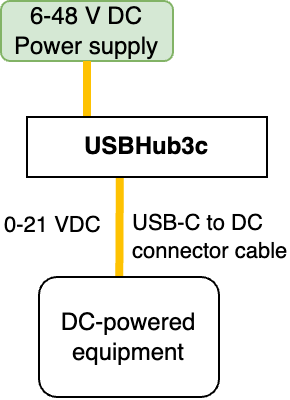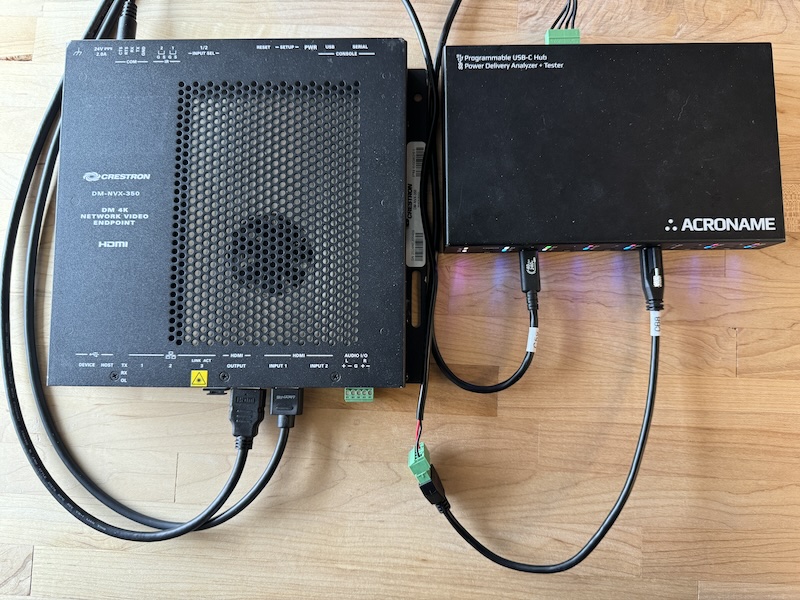
Eliminating AC/DC Wall Adapters for Low-Power Devices Using the Acroname USBHub3c
The need for more efficient, space-saving, and simplified power solutions is rising in today's increasingly connected world. Many devices, especially in the industrial, medical, and consumer electronics markets, rely on AC/DC wall adapters for power.
Each adapter is a unique system component for each power device. Still, the adapters rarely are identical in the connector interface (2.1 mm diameter, 2.5 mm diameter, ...), the required power, voltage, current rating, or even the polarity of the connector wiring. No universal standard exists; even glancing around the room, seeing more than one different AC/DC power adapter is possible.
The advancement of the USB Type-C interface and the adoption of USB-C Power Delivery (PD) allows more and more devices to work to a unified connector interface with the inherent ability of PD to adjust to a wide range of voltage dynamically, current, and power requirements. Yet, a more flexible solution is possible for devices that still rely on DC power adapters. One such tool that makes this possible is the Acroname USBHub3c, which can program power supplies for devices requiring approximately 24VDC and less than 5A.
This article explores the creation of a system using the Acroname USBHub3c in programmable power supply mode to eliminate traditional AC/DC wall adapters. We'll focus on devices that require up to nominally 24V and draw less than five amps. One can streamline power management by leveraging the programmable USB Power Delivery (PD) foundation within the USBHub3c while increasing efficiency and flexibility in various applications.
The Power Problem: Why Eliminate AC/DC Wall Adapters?
Most devices that require DC power come with a dedicated AC/DC wall adapter, which transforms the AC power from outlets into DC power suitable for the device. Depending on the device's voltage and current requirements, these adapters come in various shapes and sizes. Small industrial tools, IoT devices, LED lighting systems, and network devices needing nominally 24VDC or lower and pulling under 5A are standard.
However, traditional wall adapters come with several downsides:
- Bulky and Space-Consuming: Adapters' physical size contributes to clutter, making cable management a nightmare in multiple-device environments.
- Device-Specific: Each adapter is typically designed for a specific device, leading to incompatibility and wasted resources when devices are upgraded or replaced.
- Inefficient: Many wall adapters are inefficient, consuming energy even when the connected device is off or idle, contributing to wasted power.
A high-density DC-to-DC programmable power bank can eliminate many of these challenges.
Enter the Acroname USBHub3c
The USBHub3c is a robust and intelligent USB hub that supports USB Power Delivery (PD) up to 100 watts (20V, 5A). One of its features is the programmable power supply mode, which allows precise control over the voltage and current output. Thus, it is an ideal candidate for replacing traditional AC/DC wall adapters. Here's how the USBHub3c can be utilized in this system:
- Programmable Power Delivery: The USBHub3c can be programmed to supply specific voltage and current levels, up to 21V and 5A, making it suitable for a wide variety of low-power devices. This eliminates the need for individual adapters.
- USB-C Versatility: USB-C has emerged as a universal connector for data and power. Acroname has created a USB-C Vbus Breakout Cable for this type of application.
- Custom Power Profiles: Using the Acroname API, users can program custom power profiles for each connected device. This allows the hub to adjust the power output dynamically based on the device's needs, further optimizing efficiency.
- Multiple Devices: The USBHub3c supports many devices simultaneously, allowing users to power several devices from a single hub without needing a wall outlet for each device. This is particularly useful in lab environments, test setups, or IoT deployments.

USBHub3c Powering one DC Device
Reducing Power Draw for Idle Devices
One of the standout features of the Acroname USBHub3c is the ability to programmatically turn off specific power ports when devices are not in use. This is particularly unnecessary power draw for idle devices, which aligns with modern energy efficiency goals and is useful for refund government green initiative programs. By selectively turning off power to idle devices, one can minimize phantom energy usage (also known as standby power consumption), which is the power consumed by electronics even when not actively used.
Green Initiatives and Energy Standards
Many governments are pushing forward green initiatives to encourage businesses and consumers to reduce energy consumption. Reducing standby power usage is a crucial area of focus, and the Acroname USBHub3c can play a role in these efforts by allowing users to cut off power to devices when they are not needed. Let's look at examples of energy initiatives from the UK, European Union, and the United States:
- United Kingdom: The UK government introduced the Energy Efficiency (Private Rented Property) (England and Wales) Regulations 2015 to improve energy efficiency in businesses and homes. They also participate in the Ecodesign Directive, which limits the standby power consumption of electrical devices. By using the Acroname USBHub3c to turn off power to idle devices, organizations can meet compliance standards for energy efficiency.
- European Union: The Ecodesign Directive 2009/125/EC sets requirements for energy-related products sold in the EU. One of its goals is to reduce electronics' standby power consumption to as low as 0.5W. By leveraging the Acroname USBHub3c's ability to turn off power to idle devices, companies can achieve significant energy savings by EU regulations.
- United States: The U.S. Department of Energy (DOE) has established energy efficiency standards, and programs like ENERGY STAR promote the use of energy-efficient devices. USBHub3c's programmable power features can help organizations reduce standby power, contributing to ENERGY STAR certification and other green initiatives that encourage energy conservation.
Integrating with AV Systems: Crestron's DM-NVX-350 and AVProEdge's AC-EX70-UHD-KIT
While the Acroname USBHub3c is highly effective for simplifying power delivery, it can also be integrated with advanced AV systems to reduce the power adapters required for installation. Let's examine how it could be used alongside two standard AV solutions: Crestron's DM-NVX-350 and AVProEdge's AC-EX70-UHD-KIT.
Crestron DM-NVX-350 Example
The Crestron DM-NVX-350 is a high-performance AV-over-IP solution for transmitting and receiving 4K video over standard Gigabit Ethernet networks. It requires a nominal 24VDC power input, typically provided by an AC/DC wall adapter. However, by using the Acroname USBHub3c in programmable power supply mode, you can eliminate the need for this separate adapter.


Example setup powering a Network Video Endpoint with USBHub3c
Here's a simple example setup:
- Connect the DM-NVX-350 to the USBHub3c using a USB-C-to-barrel adapter cable.
- Program the USBHub3c to deliver 21VDC at the required current (typically less than 2A for AV-over-IP systems like the DM-NVX-350).
- Manage power delivery through the USBHub3c interface, ensuring the proper voltage and current are supplied to the DM-NVX-350.
The DM-NVX-350 does indeed power up and takes approximately 90 seconds to fully boot up.

This setup reduces the power adapters needed in the AV installation, streamlining the overall system.
AVProEdge AC-EX70-UHD-BKT Example
The AVProEdge AC-EX70-UHD-BKT is a 70-meter HDMI extender kit that supports 4K HDR video transmission over a single category cable. It requires 12 VDC power, supplied by a wall adapter for either the transmitter and receiver units, and uses Power-over-HDBaseT (PoH) to power the other unit. With the Acroname USBHub3c, you can eliminate the power adapter and provide switchable power to either RX and TX units.
- Connect the transmitter or receiver to the USBHub3c using appropriate DC barrel adapter cables.
- Set up the USBHub3c to deliver 12 VDC either device, adjusting the current limit as needed.
- The programmable hub ensures the device receives the exact power it needs, eliminating the need for dedicated wall adapters.

Example setup with USBHub3c powering a PoH HDMI extender pair from the TX side
This approach simplifies the AV setup by reducing the number of cables and power supplies, making installations cleaner and more efficient.
The Future of Power Delivery: Simplifying the Power Landscape
The ability to program power supplies using USB PD technology opens the door to a future where we no longer need proprietary adapters for every device. With USBHub3c, it's possible to create a cleaner, more efficient workspace by consolidating power supplies into one versatile hub. This approach reduces clutter and increases flexibility and future-proof installations as devices evolve and change.
Additionally, companies can reduce unnecessary power consumption by using the USBHub3c to turn off power ports for idle devices. This feature aligns with energy efficiency regulations across the UK, EU, and US, helping businesses meet compliance standards and contribute to broader green initiatives.
Add New Comment